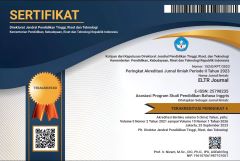THE STRENGTHS AND DRAWBACKS OF LYRICSTRAINING IMPLEMENTATION IN BASIC LISTENING COURSE
Abstrak terlihat: 1529 / PDF terunduh: 1332DOI:
https://doi.org/10.37147/eltr.v4i2.69Keywords:
computer assisted language learning, listening, lyrics trainingAbstract
Development in ICT has resulted in innovations in terms of new applications and software to use in education, one of them is in the English language teaching. This study aims to find out the strengths and drawbacks of LyricsTraining implementation as one example of the web-based CALL in the Basic Listening course, one of the obligatory courses in the English Language Education Study Program of Sanata Dharma University. LyricsTraining is a website that integrates audio and video taken from YouTube with the song lyrics. It allows the students to play the music video and requires them to type in the missing lyrics or choose from the options provided. Survey was used as the method of this study, involving 30 first semester students from one class of Basic Listening course as the participants. Questionnaire with close and open-ended questions was used to gather the data. The results of this study describe the strengths as well as the drawbacks of the implementation of LyricsTraining in the Basic Listening course experienced by the students.
Downloads
References
Bergmann, J., & Sams, A. (2012). Flip your classroom: Reach every student in every class every day. Eugene, OR: International Society for Technology. in Education.
Burns, A. (2010). Doing survey in english language teaching: A guide for practitioners. (1st ed.). New York: Routledge.
Chapelle, C. (2001). Computer applications in second language acquisition foundations for teaching, testing and research. Cambridge: Cambridge University Press.
Davies, G., (N.D.). CALL (computer assisted language learning). Retrieved on April 1, 2019 from https://www.llas.ac.uk/resources/gpg/61.
Davies, G., Walker R., Rendall H. & Hewer S. (2012). Information and communications technology for language teachers (ICT4LT). Retrieved on April 1, 2019 from http://www.ict4lt.org/en/en_mod1-4.htm#whatiscall.
Enfield, J. (2013). Looking at the impact of the flipped classroom model of instruction on undergraduate multimedia students at CSUN. Techtrends, 57(6), 14-27.
Field, J. (2009). Listening in the language classroom. Cambridge: Cambridge University Press.
Garcia, Cesar A.B. (2015). The use of lyricstraining website to improve listening comprehension. MEXTESOL Journal, 39 (3), 1-13.
Harmer, J. (2007). The Practice of English Language Teaching. Harlow: Longman.
Mills, D. J. (2010). LyricsTraining.com. The Electronic Journal for English as a Second Language, 14, 2. Retrieved on April 1, 2019 from http://www.tesl-ej.org/pdf/ej54/m3.pdf.
Humphries, S., & Burns, A. (2015). “In reality it’s almost impossible”: CLToriented curriculum change. ELT Journal, 69, 239–248. doi:10.1093/elt/ ccu081
Nation, I.S. P. & Newton, J. (2008). Teaching ESL/EFL Listening and Speaking. New York: Routledge.
Lage, M. J., Platt, G. J., & Treglia, M. (2000). Inverting the classroom: A gateway to creating an inclusive learning environment. The Journal of Economic Education, 31(1), 30–43. Retrieved from http://www.jstor.org/stable/1183338
Lee, G. (2009). Speaking up: Six Korean students’ oral participation in class discussions in US graduate seminars. English for Specific Purposes, 28, 142– 156. doi:10.1016/j.esp.2009.01.007
Lockwood, Brinks. (2014). Flip it! Strategies for the ESL classroom. Ann Arbor: University of Michigan Press.
Milman, N. B. (2012). The flipped classroom strategy: What is it and how can it best be used? Distance Learning, 9, 85–87.
O’Donoghue, M. (2014). Producing Video for Teaching and Learning. Planning and Collaboration. New York: Routledge.
Rajesh, M. (2015). Revolution in communication technologies: impact on distance education. Turkish Online Journal of Distance Education-TOJDE, 16(1), 62- 88.
Solomon, G. & Schrum, L. (2007). Web 2.0: New Tools, New Schools. Eugene, OR: International Society for Technology in Education.
Spino, L. A., & Trego, D. (2015). Strategies for flipping communicative language classes. CLEAR News, 19, 1–5.
Vaughan, M. (2014). Flipping the learning: An investigation into the use of the flipped classroom model in an introductory teaching course. Education Research and Perspectives International Journal, 41, 25-41
Downloads
Published
How to Cite
Issue
Section
License
Copyright (c) 2020 Patricia Angelina

This work is licensed under a Creative Commons Attribution-ShareAlike 4.0 International License.













